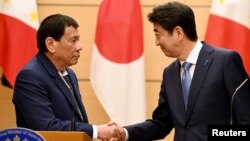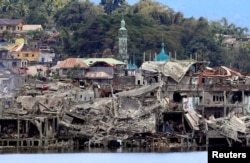Japan is deepening its influence in the Philippines to vie with regional rival China, a welcome boost for an infrastructure overhaul program in the relatively poor Southeast Asian country and for Japanese geopolitical ambitions.
Philippine President Rodrigo Duterte met Japanese Prime Minister Shinzo Abe earlier this week to discuss “concrete, time-bound and specific ways to further intensify bilateral cooperation,” the presidential website in Manila said.
Duterte is playing Japan off China, which last year out-pledged other countries with an offer of $24 billion in aid and investment, analysts say. China and Japan, which have a legacy of two-way political disputes, are vying for economic inroads as well as military cooperation in much of Southeast Asia.
“He’s playing one side off the other, and so he’s come to ‘why not?’” said Jeff Kingston, author and history instructor at Temple University Japan. “Japan is trying to draw on its old ties and ‘we’re a more reliable and trustworthy neighbor.’”
Duterte’s second trip to Tokyo
Duterte, in office since June 2016, made his second official Tokyo visit Oct. 30-31. His meeting with Abe included discussions of economic issues. Abe pledged 1 trillion yen ($8.8 billion) in economic support, according to media reports from Tokyo this week, doubling the amount that Japan offered in January.
The aid is expected to help the Philippines build rapid transit, bridges and improvements to a container port in the country’s third largest city, Cebu, said Jonathan Ravelas, chief market strategist with Banco de Oro UniBank, Metro Manila.
“On top of our agenda is vital support for the centerpiece projects,” Duterte said via the presidential office website, referring to a $167 billion, five-year program to overhaul public facilities as a way of fostering stronger economic growth.
Testing Chinese aid
The Philippines began accepting Chinese aid for infrastructure last year after the two sides agreed to set aside a maritime sovereignty dispute that had landed them in a world arbitration court under Duterte’s predecessor.
Beijing hopes its economic help around Southeast Asia will ease opposition to its dominance in that dispute, which covers most of the South China Sea and involves six governments. Some Filipinos worry that acceptance of Chinese aid will lead to compromising Philippine maritime sovereignty claims.
For the past four years, China has separately advanced a “One Belt, One Road” policy that extends infrastructure aid across Asia to advance Sino-foreign trade relations.
What’s in it for Japan
Japan is widely seen as competing with China for clout in the Philippines as well as other developing Asian countries.
Direct aid worldwide increased 12.7 percent last year over 2015 to $10.37 billion. The development aid also has a widening mandate, including “human security” and “sustainable development” based on individual country needs, the Japanese foreign ministry says on its website.
Japanese support for the Philippines tends to unfurl slowly compared to Chinese support, and often comes through private investment deals such as aquaculture in remote, undeveloped regions. Both countries offer concessionary loans.
“Foreign direct investment in the Philippines coming from Japan has been growing in the past six years, so I think closer cooperation between these countries is beneficial,” Ravelas said.
China and Japan still face unresolved issues from World War II as well as a dispute over islets in the East China Sea.
The East China Sea issue, plus wariness about Beijing’s grip on the South China Sea — a separate dispute not involving Japan — have prompted Tokyo to factor in freedom of navigation, rule of law and security when making aid calculations, University of Adelaide Asian studies professor Purnendra Jain wrote in a 2016 online commentary.
Japan, a staunch ally of Washington, also advocates a multicountry approach to development assistance.
“Duterte was in town at [the] Japanese invitation and I think they wanted to convince him,” Kingston said.
Japanese help for destroyed Philippine city
As part of Japan’s emphasis on human security, Abe offered $2 million to help the Philippines rebuild Marawi, Philippine media reported this week. Marawi is a southern city that was demolished during five months of fighting this year between Philippine troops and Muslim rebels.
“In the past the focus has mostly been on infrastructure and grants, but now there’s an effort to try to address human security issues like the roots of conflict, and terrorism,” said Maria Ela Atienza, political science professor at University of the Philippines Diliman.










